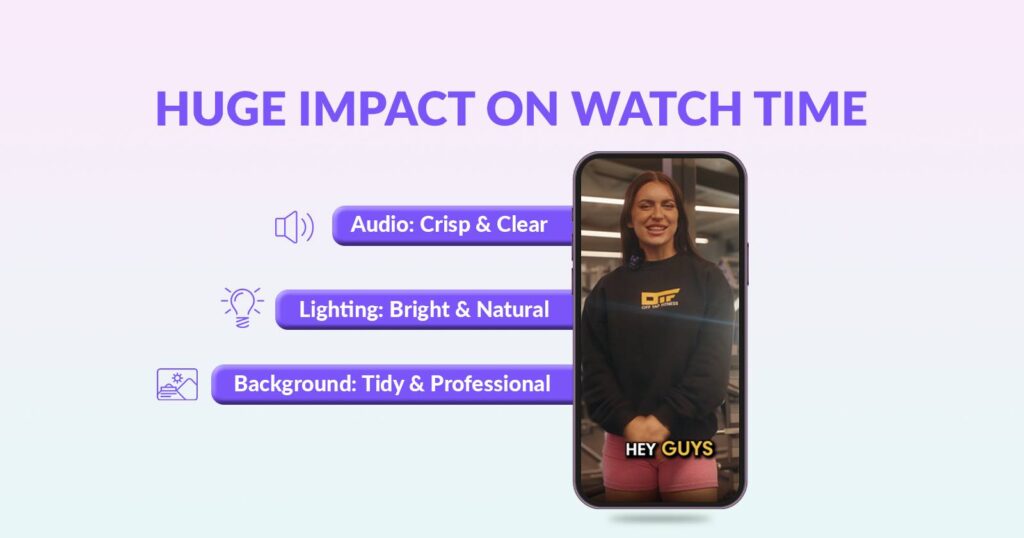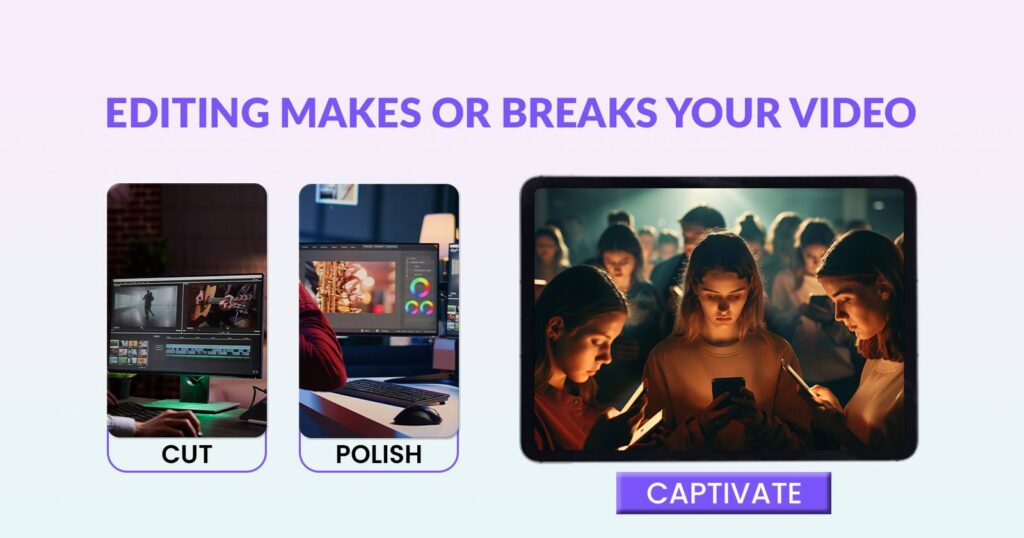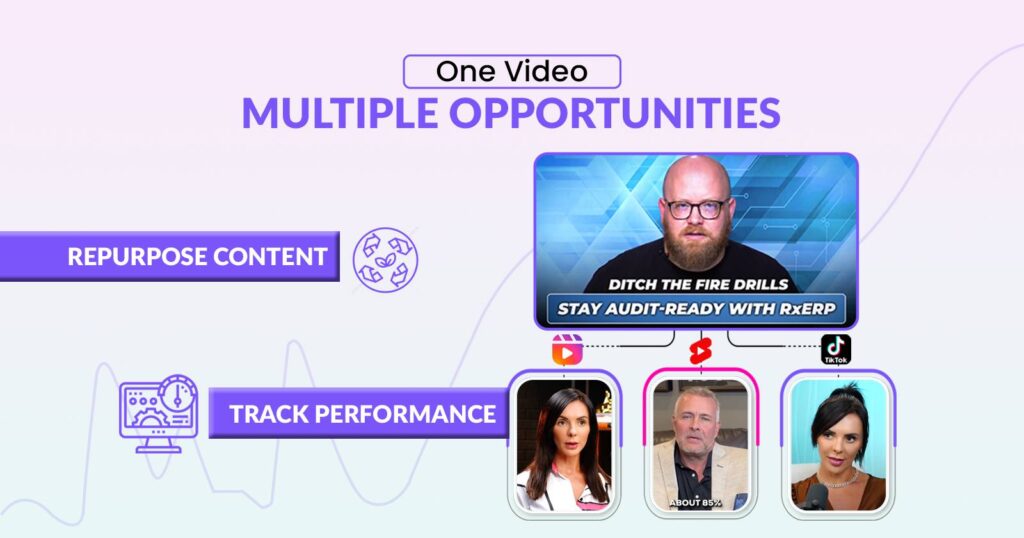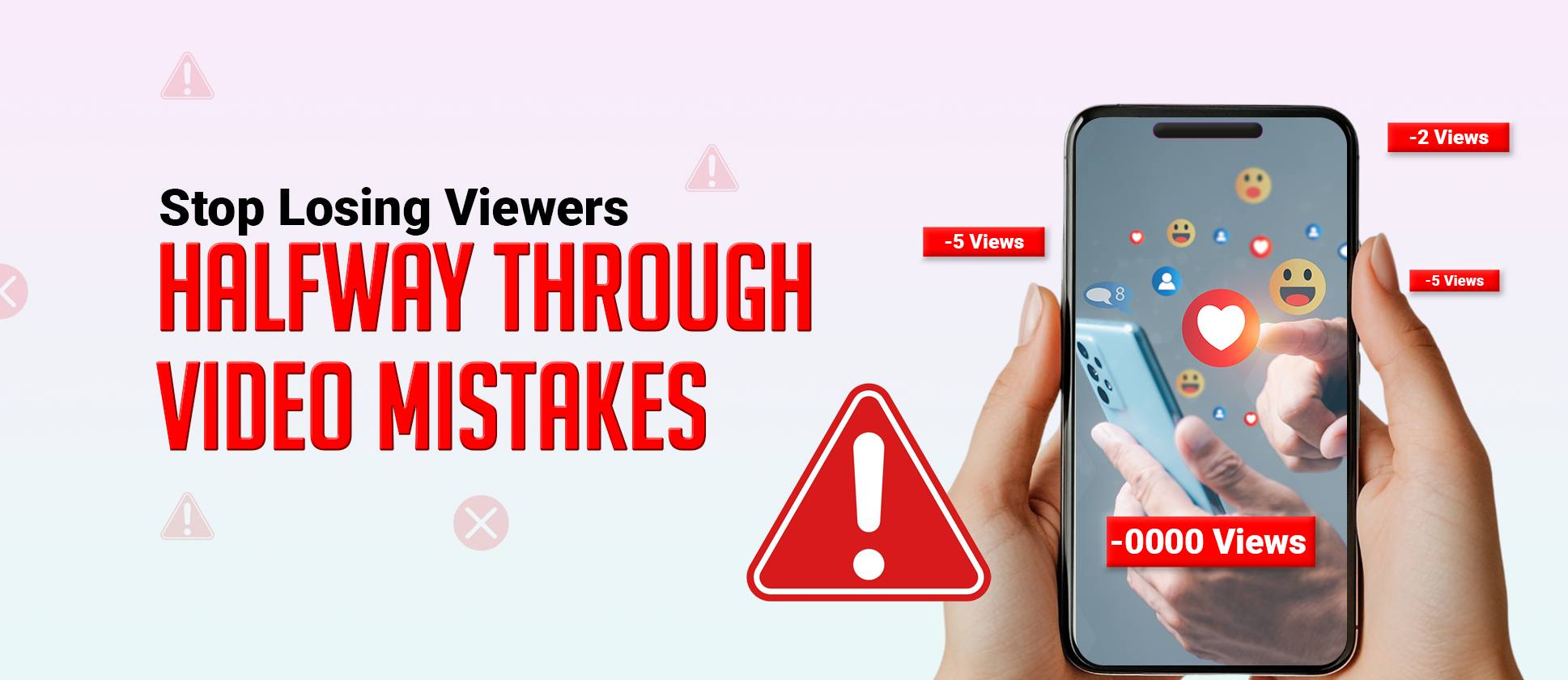Quick Summary
TL;DR: Long-form videos can drive strong watch time and audience trust in 2026, but only if they’re planned, structured, edited, and optimized properly. Most creators lose viewers due to poor planning, weak hooks, messy production, or a lack of a distribution strategy. #tldr
- Core Factors:
Planning → Audience Fit → Production Quality → Story Flow → Post-Production → SEO → Repurposing
- Mistakes to Avoid:
No Plan → Confusing flow
Wrong Audience → Low relevance
Bad Audio/Lighting → Early drop-offs
Dragged Length → Boring pacing
Weak Editing → Choppy experience
No SEO → Low discoverability
No Repurposing → Wasted content
- Key Insights:
Viewers stay longer when videos open with a strong hook and good quality audio.
- Final Takeaway:
Long-form video is still one of the most effective formats in 2026, but success depends on solid planning, relevance, clean production, strong editing, and smart optimization.
Long-form video typically exceeds 5 minutes or more, allowing for in-depth storytelling, detailed explanations, or extended entertainment. They are everywhere these days, from YouTube podcasts to webinars and branded series. People are willing to spend more time watching in-depth content if it’s done well. For brands, creators, and businesses, engaging with long-form video content is a huge opportunity in 2026. The problem? Many creators continue to make long-form video mistakes, which is impacting their projected reach.
When creating content, it’s easy to fall into habits like jumping in without a plan, letting the story drag, or ignoring editing details. These missing elements might seem minor, but they often lead viewers to drop off halfway through a video or result in content not performing as expected.
The truth is, making long-form content isn’t just about hitting record for 20 or 30 minutes. It’s about building a flow that feels structured yet engaging, and editing it in a way that keeps people watching until the end. In this article, we’ll discuss the 7 most common long-form video mistakes and how to avoid them. And if you’d like a professional hand to polish your videos, our best video editing tips can help bring your content to life.
1. Skipping the Planning Stage

One of the common mistakes in long-form video is starting to record without a plan. Shooting can be exciting, but without a clear goal or script, it often becomes messy and confusing. Viewers notice this right away, and many may not watch 20 minutes of scattered thoughts. It’s important to keep your content clear and organized to hold their interest.
Imagine uploading a 20-minute video that jumps from topic to topic without a clear hook or storyline. Even if the content is valuable, the lack of structure makes it hard for viewers to follow along. That’s how watch time and engagement start to drop.
The fix is simple: always know your “why” before you press record. What’s the purpose of this video? Who are you talking to? What should they walk away with? Once you’ve nailed those answers, build a loose script or outline around them. If you’re not sure where to start, our script content services can help you plan videos that flow naturally and keep audiences watching.
2. Ignoring the Target Audience
A common mistake with long videos is forgetting who the audience is. It’s easy to focus on your own ideas, but if the topic doesn’t interest your viewers, they will stop watching. A HubSpot study found that 54% of viewers quit watching if the content isn’t relevant to them. That’s more than half your audience gone before you even get to the main point.
Think of it this way: imagine making a 30-minute deep dive into advanced editing software tips when most of your viewers are beginners. Even if your advice is solid, the mismatch means your video won’t land the way you hoped. The same goes the other way – oversimplifying for an expert audience can feel like a waste of their time.
To avoid issues, start with audience research. Get to know your audience and the challenges they face. It’s really helpful to use tools like YouTube Analytics, Google Trends, or social polls to find out what they’re interested in. Don’t forget to do some keyword research to see what people are searching for as well. When your video topics resonate with your audience’s needs, you’ll see better viewer retention, making your videos even more engaging, and you have a chance to go viral with that content.
3. Poor Production Quality (Audio, Lighting, Background)
You’ve probably heard this before: people will forgive a slightly shaky camera, but they won’t forgive bad audio or lighting. And it’s true – production quality can make or break a long-form video. Viewers might give you 30 minutes of their attention if the content is engaging, but if they’re straining to hear you, distracted by shadows, or staring at a cluttered background, they’ll click away in seconds. Let’s break it down:

Bad Audio
Nothing makes people leave a video faster than a muffled, echoey, or crackling sound. You could be sharing game-changing insights, but if the audio hurts their ears, they won’t stick around. Remember, most viewers multitask – they might be listening while driving, cooking, or working. If your audio isn’t clear, your message never reaches them.
Fix: Invest in a decent external microphone. Even an entry-level lapel or USB mic is miles better than your laptop or camera’s built-in mic. Also, record in quieter spaces and use simple noise reduction tools during editing.
Poor Lighting
Good lighting isn’t about looking glamorous; it’s about looking professional. Harsh shadows, dim rooms, or bright windows behind you can make your video feel cheap, no matter how good your content is. Poor lighting also makes it harder for viewers to connect with you on a personal level because they can’t clearly see your face and expressions.
Fix: A basic 3-point lighting setup (key light, fill light, and backlight) instantly levels up your production. If you’re on a budget, natural light from a window can work wonders – just face the light instead of having it behind you.
Messy Background
Your background says a lot about your brand. A cluttered room or distracting décor pulls attention away from your message. People might spend more time analyzing the pile of laundry behind you than listening to what you’re saying.
Fix: Keep it simple. A clean, neutral background or even a branded setup with a few intentional props works best. If you’re short on space, a backdrop or even a blurred effect can help create a professional look.
Bottom Line
Production quality is about removing distractions so your audience can focus on your message. A clear voice, well-lit frame, and tidy background tell viewers you respect their time, which makes them far more likely to keep watching.
4. Creating Extra Long but Boring Videos
One of the major mistakes is thinking long-form video just means dragging content out for the sake of it. The truth? A 20, 30, or even 60-minute video can hold attention if it has a clear purpose and keeps moving. The problem comes when the video
- Lacks a strong hook at the start.
- Wanders without clear direction or flow.
- Offers no real reason for viewers to stay until the end.
At that point, length becomes a liability, and most viewers will drop off halfway through. Think about your own habits. You’ll watch a long YouTube video or podcast if
- The host grabs your attention quickly.
- The story is interesting and easy to follow.
- Content is structured with natural breaks or signposts.
But if the intro drags or the video meanders, you’ll likely click away. Your audience feels the same.
How to Fix It
- Hook early (first 15 seconds) – Start with a bold statement, surprising fact, or quick preview of what’s coming.
- Tell a story – Even educational videos should feel like a journey. Use b-roll, examples, or short anecdotes to keep momentum.
- Add structure – Chapters and timestamps guide viewers, making content easier to navigate and encouraging them to return later for specific sections.
When long-form content is engaging, has purpose, storytelling, and structure, viewers are far more likely to watch all the way through.
5. Neglecting Post-Production & Editing
Post-production is very crucial, and editing is the stage where everything comes together. You can shoot great video and record crystal audio. If the editing is rushed, the video will not have the desired effect. Awkward cuts, uneven pacing, and long pauses make videos hard to watch. Viewers might not always know why they feel disengaged, but poor editing is often the reason.

One of the big mistakes in long-form video post-production is skipping the basic things like captions, transitions, and consistent branding. Captions help keep people watching videos, especially when the sound is off. This happens more often than you would think. Smooth transitions make the video flow better and less choppy. Branding reminds viewers who created the content, making it easier to remember. These small details together give a video a polished look and feel.
Editing is not about adding flashy effects. Instead, it shapes the story. Good editing cuts out what does not add value, adjusts the pace to feel natural, and includes supporting visuals or b-roll. This makes long videos easier to watch. When editing works well, you don’t notice it, but you feel its impact. Without good editing, the video can feel rough.
If editing is not your strength, you have options. You can learn to use AI video editing tools like Runway ML, Descript, or Pictory AI and improve your skills. Or, you can hire professional editors or agencies like ShortVids, which specialize in long-form content. They know how to keep an audience engaged and ensure the video flows smoothly.
It also helps to stay aware of where editing styles are going. Long-form video trends change quickly, and keeping up with them can give your content a modern edge.
6. Forgetting SEO & Distribution
Spending weeks creating and editing a video only to hit “publish” and hope for the best is one of the biggest mistakes creators make while publishing long-form video. Without proper SEO and a clear distribution plan, even the best videos can get buried.
Why This Hurts
- Uploading without keywords, tags, or a strong description is like publishing a book without a cover.
- Search engines and platforms need context to understand your content and connect it with the right audience.
- Ignoring optimization makes it nearly impossible for people to find your video.
SEO Essentials to Never Skip
- Add keywords in your title, description, and tags.
- Write a clear, keyword-rich description (don’t just leave it blank).
- Use transcripts and captions so algorithms can “read” your video.
- Optimize your thumbnails and metadata to increase clicks.
Distribution Done Right
- Don’t let your video live on YouTube alone. Repurpose clips with tools for TikTok, LinkedIn, or Instagram.
- Embed your video into related blog posts to add depth and boost SEO.
- Share highlights in email newsletters or online communities where your audience already hangs out.
- Break long videos into short clips to attract new viewers and funnel them back to the full version.
Don’t Forget the Call to Action
If someone watches your video to the end, they’re interested. Guide them to the next step:
- Subscribe to your channel
- Visit your website
- Watch another related video
Bottom line – Creating a video is only half the job. Making sure people can actually find it, and know what to do next, is what transforms views into real results.
7. Not Repurposing or Tracking Performance
One of the major mistakes with long-form video is treating it as a one-time project. After all the effort in planning, filming, and editing, the content often remains unused post-publication. This not only wastes potential value from repurposing but also misses out on opportunities for performance improvement.

Long-form video is a goldmine for repurposing. Inside a 30-minute video, you might have five or six great moments that could be turned into short clips for TikTok, Instagram Reels, or LinkedIn. Content repurposing is about getting more reach from what you already created.
Tracking performance is just as important. Without data, you’re guessing whether your content worked. Watch time, for example, tells you how long people stay engaged. Click-through rates show whether your CTA is effective. Conversions reveal if the video is doing its job in moving viewers closer to your goal.
Here are a few practical ways to cover both sides.
Repurpose your Content
- Cut highlights into short-form videos for social platforms.
- Transform main ideas into compelling email content.
- Create quote cards or graphics for quick social posts.
Track your Performance
- Use YouTube Analytics to check retention and watch time.
- Look at click-throughs on your CTAs.
- Track conversions with tools like HubSpot dashboards or Google Analytics.
The creators and brands who get the most out of long-form video are the ones who treat it as part of a bigger strategy. Repurposing extends its reach, while tracking ensures every new video is better than the last.
Bonus Tips to Make the Long-Form Video Stand Out and Avoid Mistakes
Long-form video can be really effective, but it works best when you pay attention to small details and avoid these mistakes. A few simple adjustments can make your videos easier to watch and more engaging.
Add Subtitles for Accessibility
Subtitles are a simple way to make your videos more inclusive. Many people watch videos without sound, whether they are on public transport or in a quiet space. Captions help your message reach everyone. They also support viewers who have hearing difficulties. Automated captions are useful, but reviewing them ensures accuracy. Subtitles help more people enjoy your content fully.
Use Storytelling Frameworks
Even longer videos can really benefit from a clear structure. A great way to keep viewers interested is to kick things off by talking about a problem, then show how to solve it, and wrap up with the results. This makes it easier for people to follow along. Start with a challenge your audience can connect with, break down your solution with simple steps or examples, and then share the outcome with some numbers or stories. This way, it feels like the viewers are on a journey, and the video becomes more relatable and easier to understand.
Collaborate with Influencers or Guests
Adding other voices can make your videos more interesting. Bringing in influencers or experts adds credibility and can introduce your content to new audiences. Try to work with people whose style matches yours so the conversation feels natural. Even a short chat or interview can make your video more dynamic and give viewers a reason to watch until the end.
Small touches like these can make a big difference. Subtitles, clear storytelling, and guest collaborations help your videos connect with viewers and make them more enjoyable to watch.
Common Long-Form Video Mistakes in Table Form and How to Fix Them
Here are the key issues creators face and how to address them efficiently.
| Mistake | Impact on the Viewer | Quick Fix |
|---|---|---|
| Skipping Planning | Confusing flow, low watch time | Outline your video, define purpose & target audience |
| Ignoring Audience | Low engagement, irrelevant content | Research audience needs & interests; use analytics & keywords |
| Poor Audio/Lighting/Background | Hook viewers in the first 15 seconds, add storytelling, and use chapters/timestamps | Invest in an external mic, proper lighting, tidy or branded background |
| Making Videos Too Long & Boring | Viewer drop-off | Hook viewers in the first 15 seconds, add storytelling, use chapters/timestamps |
| Neglecting Post-Production | Choppy pacing, unclear message | Edit carefully: cut unnecessary parts, add captions, transitions, branding |
| Forgetting SEO & Distribution | Low discoverability | Optimize titles, descriptions, tags; promote across social & blogs |
| Not Repurposing / Tracking | Wasted content potential, missed insights | Create short clips, track watch time & conversions, improve future videos |
Final Words to Avoid Long-form Video Mistakes
Avoiding these seven long-form video mistakes can make a big difference in your content strategy. By focusing on planning, storytelling, editing, and repurposing, you’ll see better engagement, higher search rankings, and stronger conversions.
If you want to take your videos to the next level, consider checking out ShortVids’ Long-Form Video Editing Services. Our team ensures every video is professional, polished, and optimized for your audience.
FAQs About Long-form Video Mistakes
Not at all. Long-form content remains highly valuable, especially for building authority, engaging loyal viewers, and driving watch time. Trends show short-form content is growing, but long-form videos still play a key role in audience retention and monetization.
YouTube is the clear leader for long-form videos due to its algorithm, monetization options, and search visibility. Other platforms like Facebook, LinkedIn, and IGTV can also work, depending on your audience.
Typically, videos longer than 10 minutes are considered long-form. However, 15 to 30 minutes is ideal for in-depth tutorials, interviews, or storytelling content that keeps viewers engaged.
Tell a story in your video. Organize it into clear sections, and put hooks at the beginning to grab attention. Make sure the production quality is high. You can also use highlights as short clips to reach more viewers and increase engagement.
It depends on your goals. Long-form content is better for watch time, authority, and monetization, while short-form content is excellent for discovery and quick engagement. Many successful creators use both strategically.
Long-form video is content that lasts 10 minutes or more. It goes into topics in detail and includes structured storytelling, multiple segments, and in-depth information.
The best approach is a mix. Shorts are great for discovery and virality, while long-form builds authority, audience loyalty, and conversions. Use each format to complement the other for maximum impact.
Book a Call Today
- Fixed monthly plans starting at $999
- 24-hour turnaround time (or less) on all short-form edits
- 3-layer quality check system on every video
- No more chasing freelancers or managing editors
- Scale up to 50+ videos/month without hiring in-house
- Content team trained on platform trends, scroll-stopping hooks & storytelling
- Fully managed by professionals – you just upload & approve
- Response time: Under 1 hour (US & GCC time zones)
Cut your production costs, not your standards.


